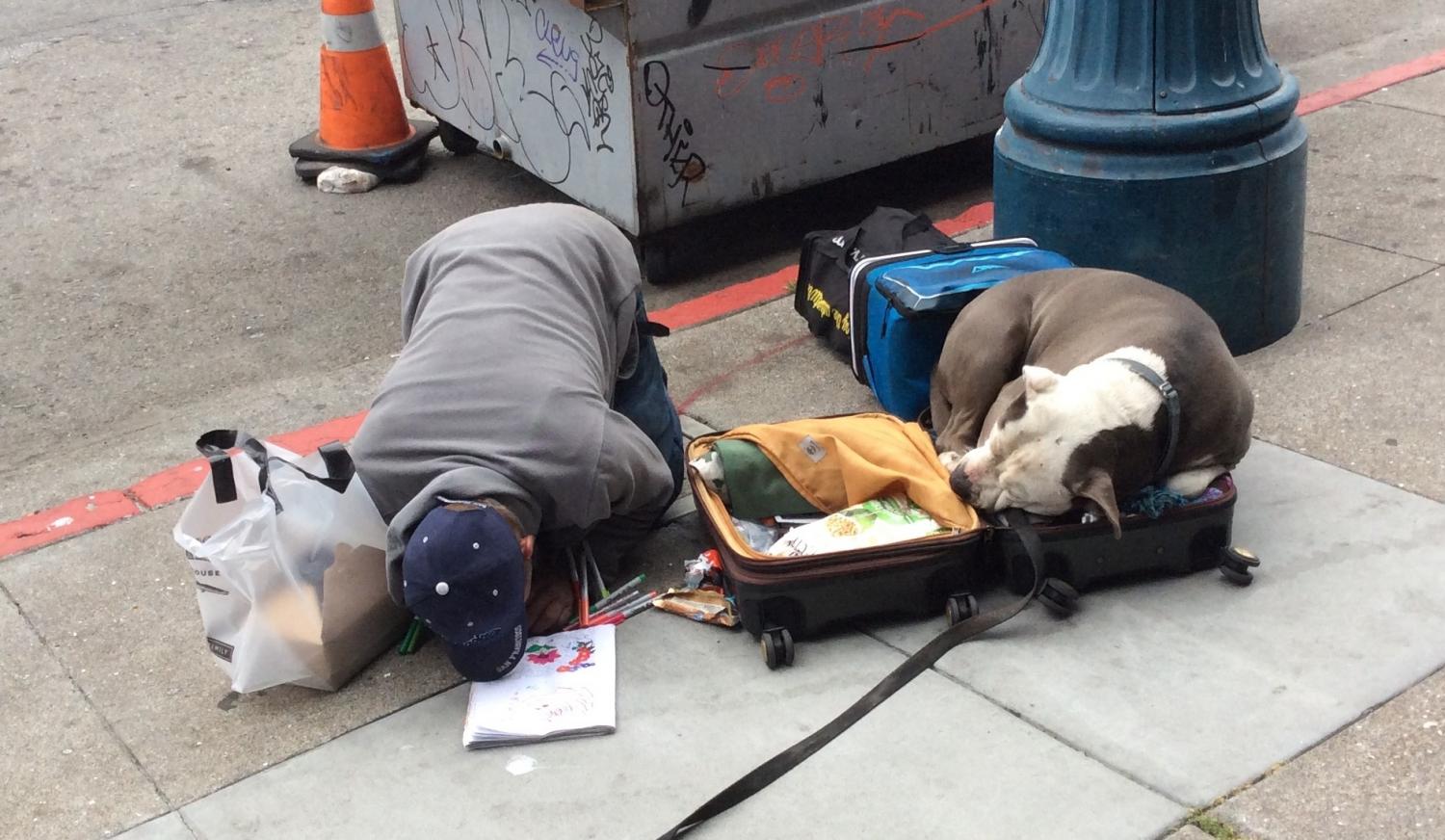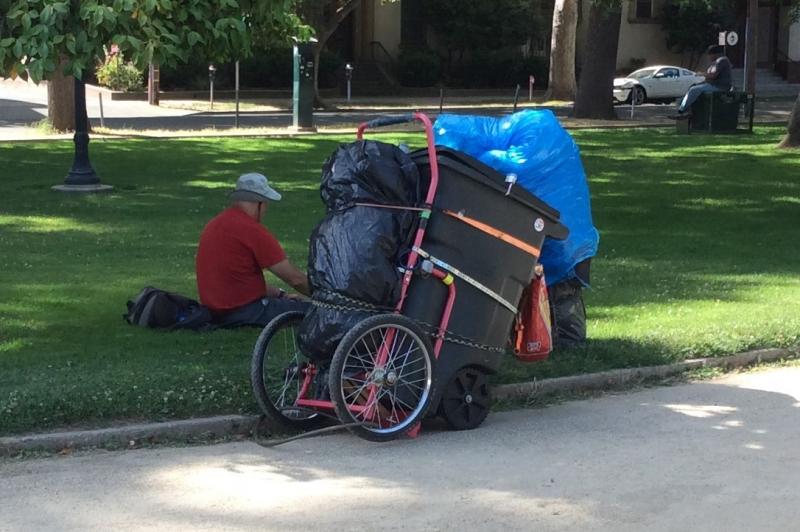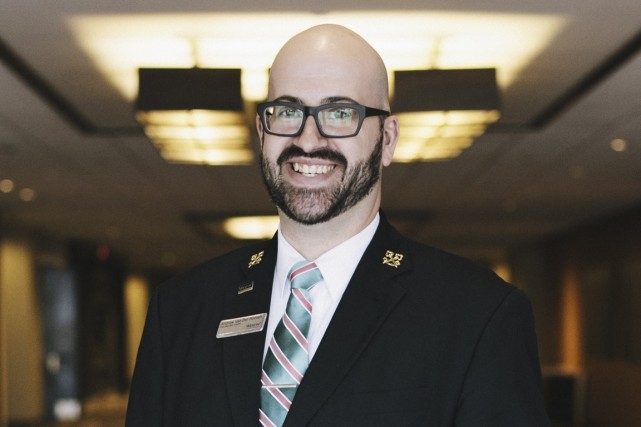
Madonna: Tragic epitome of homelessness
She was soaking her swollen feet in the small outdoor hot tub at a Motel Six hotel located on Highway 101 about an hour south of San Francisco, in the summer of 2019. The person appeared to be a senior female with a weathered, well lined, tanned visage, and a slightly plump average body. She had pendulous, full, peppered grey-brown braids hanging casually almost to her waist, on the front of a red plaid long sleeve shirt and cut-off, knee length shorts. She was engrossed in reading a thick paperback novel, which turned out to be a popular one currently on the New York Times bestseller list. I accepted the seduction of the frothy whirlpool and let my fleshy self sink under the warm soothing waters up to my neck, positioning myself across from her, wondering just who this unlikely economy motel guest visitor might be.
I interrupted her intense involvement with a compelling read, and remarked on the pleasure of the sun-filled garden and heat of the hot tub water on my aching arthritic joints. She looked up, as if surprised I might actually want to speak with her. When I asked her name, she identified herself simply as ‘Madonna’.
We shared much that day in our chance encounter. Much about the beauty of the California coastal regions, much about religion and much about politics. This woman proved to be very well read, articulate and obviously exceedingly intelligent. She was also a homeless person.
We befriended each other for an hour or so that day and I absorbed in considerable detail, the story of this homeless woman’s tragic life, which she openly reiterated to me with a calmness and acceptance that astounded me. She was a survivor of the cruel fate of so many of our innocent children born, without one iota of choice, into destinies that are regularly played out in the so called developed world, including unfortunately our own beloved Canada.
Madonna was born in a city in Southern California, USA, to a teenage mother along with a sibling, whom their irresponsible uncommitted biological father abandoned. She returned home one afternoon after school at the tender age of eight, to find her young drug-addicted mother with her pants down around her ankles, a needle in her arm and a mask of death covering her once beautiful face. The old woman recalled in minute detail the trauma of this horrific scene, being placed alone in the rear seat of a police car and delivered into the nefarious jaws of the foster care system where her life journey got even more difficult.
A foster home brought her educated foster parents, decent food and shelter. But it also brought her sexual abuse and assault from the foster father. When she told a child protective services worker, the system decision makers decided she needed mental health services and rehomed her in a mental institution. She got services there alright, but she also was raped many times by an orderly who worked at the facility. After a couple of years she decided to try to escape and run away to whatever the larger world might bring which could in her mind, only be better than her life in the mental institution. She ran, was picked up, rehomed, and then she ran once more. This cycle continued until the system gave up and she made her home among so many others without an address of their own.
Other homeless persons became her friends. They became her family. They became her refuge and her teachers. She learned young survival skills known only to this population. She learned the talk, the walk and the tricks of the trade for a lifetime calling to living on the streets.
Her teenage years introduced her to poverty, hunger, crime, prostitution, thievery, motherhood, drugs, homelessness, hitch hiking, pimps and unsavoury selfish men who used and abused her. She lost her first unplanned son to the foster care system after a while and at 21 married and had 2 more children. This union brought more abuse and the loss of all her children to Child Protective Services. She got out of this marriage, a battered woman, to go back to the streets where she resumed a life with drugs and bore yet another unplanned child. This one ended up with Madonna’s sibling and became estranged from her when the well intentioned sister tried to remove Madonna from the child’s life, thinking that was in the best interests of the small girl.
Along the way, efforts at drug rehabilitation occurred and I suspect some incarceration time because she told me she was just three credits short of her degree and was a compulsive reader of all kinds of books, including biographies and nonfiction typically read by well educated people. She also told me she had worked for about 7 years in respectable, responsible jobs. How those features were present in this life story, puzzled me somewhat given the trajectory she described for much of her growing up years and adult life, so I have filled in the blanks with a guess on this. She told me she had travelled all across North America by hitchhiking, that 2 of her 4 children died of drug overdoses and 1 lost his legs in a motorcycle accident and lived on the streets as well. She thought the 4th might be doing alright somewhere out of the USA, but really could not be sure as there was no longer any contact.
Now Madonna was 61 years old and said she was unable to get by on the streets because of her age, whatever that meant. A ‘friend’ had told her about some senior subsidized housing possibilities in the wealthy community where we both were staying that night and had paid her costs associated with application for a unit. She had received disappointing news from city officials that the waiting list was very long and a unit for her could be more than four years away, if at all. She was unsure just what she would do until something came up. More of the same, she anticipated. More of life on the streets.
I expressed to Madonna my sincere admiration for her courage, positive attitude and continued faith in her Creator, to whom she prayed for all good things and to whom she attributed her strength to survive and cope with her challenging life circumstances. I asked her with great interest in her response, exactly what she felt could have helped her life turn out more positively. Her answer was not a surprise to me as I have seen this kind of story repeated over and over in my career as a social worker. A stable home and a caring competent adult mentor was her thought. Close to what I would have said, but likely not as succinctly and as articulately as she put it. And definitely not with the depth of personal pain, knowledge and lived tragic experience that was breathed into her hushed, hopeless flow of thoughts.
Before I left the hot tub area, I thanked Madonna for sharing her life story with me and trusting me with the gut wrenching emotional expression of a long series of incredibly dreadful events. It was a woeful tale about a once bright little girl whom adults did very, very wrong from an early age. It resulted in a sad, horrific life. And there did not seem to be an end in sight to the gargantuan kinds of struggles still facing Madonna, that would put most of us middle class folk permanently depressed and out of commission in hospital dealing with only a couple of them.
The story of Madonna is not an uncommon one. It could be photocopied a thousand times over, and by changing the name and a few details of the central figure, would come close to the life stories of so many of the men and women who are called ‘homeless’. Not many caring adults with hearts of flesh could avoid shedding more than a few tears when reflecting on the unfortunate children and youth, or persons with mental illness, addictions, or both, walking this treacherous path, whom they meet in the social service, medical or educational system.
Accurate data on this population in the United States and in Canada is difficult to find, mainly because even counting the population is fraught with troublesome and methodological problems abound in research about them. Even coming up with a definition of the population is problematic and varies from study to study making comparisons and conclusions problematic.
There are homeless people who live on the streets. Some find shelter in cardboard boxes, under stairwells, in doorways, under tents or makeshift structures in parks or along roadways and in group encampments squatting on unused land. Some are defined as homeless persons who find shelter in community overnight facilities called ‘Shelters’. Some are included in the definition of homeless persons if they are put up in temporary accommodation such as inexpensive motels and hotels by social services. Some definitions include couch surfers who stay a few days here and a few days there with friends, relatives or others they become acquainted with in their travels who share a connection with them. Others include in the homeless population those who are at significant risk of losing the accommodation they have because of non payment of rent, mortgage foreclosure, eviction for unacceptable behaviours or because their group living situation has broken down and they no longer can afford to remain where they are.

The epidemic proportions of the visible homeless living on the streets in California, USA, came home to me in a recent vacation to that state. A seasoned tour bus guide estimated the street homeless in San Francisco at approximately 100,000 and that population in Los Angeles at approximately 300,000. A June 10, 2019 editorial in the Los Angeles Times approximated numbers in LA County at 100,000. I saw all kinds of homeless persons living on the streets and in the parks in virtually every place I visited including Sacramento, Salinas, San Francisco and Santa Barbara. Fox News had prepared me for this because it ran a series on this subject in the spring of 2019 with extensive film footage of huge numbers of visible homeless in scads of major American cities.
The impact of the growing number of street dwelling homeless is disturbing to say the least. Human feces on sidewalks and used needles littering populated business and residential areas are so problematic cities have paid work positions for ‘Poop Scoopers’ and many public washrooms have receptacles for used needles. Security people try to move this population out of the tourist areas so they become invisible and I noted there were none present in elite districts of any community I visited where the wealthy reside. City bus tours purposely omit showing tourists areas of the city where visible homeless crowd the street, or sleep, lie or collapse on them, because, according to my tour guide ‘tourists do not want to see that’. Business owners discover encampments in front of their stores and offices which frighten and deter customers from accessing their services. Officials discussing city budgets in Los Angeles, according to the June 10, 2019 LA Times, debated financial costs rather than the needs of their homeless population in a discussion about mobile, staffed bathrooms. The report indicated that each one would cost $300,000 annually and estimates for provision of toilets and showers for every encampment in LA would cost more than $57 million a year. Crime, drug problems and prostitution flourish in these environments and costs to manage them are rising steadily. Rats, garbage and filth abound in many encampments creating the emergence of diseases common to the Middle Ages like typhus, which now is a health hazard for tax paying citizens.
Canada is not immune to this growing social problem. A website entitled ‘Statistics on the Homeless in Canada’ says accurate numbers in Canada are unknown but some government reports say 150,000. Experts on poverty, homeless and housing say about 300,000. A site entitled ‘What is Homelessness-Raising the Roof’ suggests 235,000 with 20 per cent living on the streets.
In Ontario, Elise von Scheel in ‘Homeless shelter demand rising in Ontario as facilities close’ written in September 2017, says that: “Finding a permanent place to call home is a nearly impossible task for some 12,000 Ontario homeless persons who use shelters. According to the 2016 Census, 8,780 people in this province declare a shelter as their primary residence.170, 000 plus households are on waiting lists for affordable housing with an average wait time of four years according to the Ontario Non-Profit Housing Association. Numbers have been rising dramatically while dozens of shelters have been closed and those remaining ‘so full that they have been filling the hallways with sleeping mats’.
In Ottawa, an April 11, 2016 United Way article entitled ‘Homelessness: Ottawa’s progress’ estimates numbers in the capital at 6,815 in 2015 and 7170 in 2016.The biggest surge in numbers seems to be in females over 60 and single youth. A Jon Willing, March 2018 article in the Ottawa Citizen called ‘City Records spike in homeless families as it assesses midpoint in 10 year plan’ says that family shelters have been overwhelmed, many persons being housed in hotels and motels, with an average of 1,180 people in emergency shelters each night in Ottawa, last year. There are 10,597 households on a waiting list for subsidized housing and applications in 2017 were 3 times more than the number of households housed through the waiting list. In 2017, the numbers of persons requesting social assistance through Ontario Works rose by 3.6% while Ontario Disability Support Program saw an increase of 2.15% as well. A comprehensive article by Jacob Hoftema in the Ottawa Citizen on September 7, 2019 entitled ‘National Housing Strategy not enough to fix the city's growing crisis: advocates’ discusses the homeless crisis in Ottawa in detail and the need for more funding from leaders at all levels to meet the housing needs of citizens that require affordable options.
The story of Madonna encapsulates in one woman three major groups among the visible homeless: Those from unhappy, negative childhood backgrounds who run away as teenagers ill prepared to be safely independent; Those with significant mental health issues who are ill; Those with addictions who are ill. Adverse childhood experiences or ACE, contributes to the creation of all three groups in a major way. These people are usually unconnected to competent caring safe adults on whom they can depend for the basic necessities of life, in childhood and subsequently in their lives as adults on the streets. Persons with these profiles often end up homeless.
The solutions to the absence of a permanent residence to call ‘ home’ for every citizen are complex, complicated and multifaceted. Many assorted efforts have been made and many strong advocates and leaders are working hard on this social problem as we speak. Research abounds on the issue and solutions include such ideas as societal structural change, systems prevention, early intervention, eviction prevention and housing stability as outlined by Stephen Gaetz and Erin Dej in ‘ A New Direction: A Framework for Homelessness Prevention’. Additional money through social assistance to the individuals does not solve the problem because of the dirth of available affordable housing, the undesirability of some of these persons as tenants for many landlords and the inability of many of the homeless to follow through and spend additional funds on accommodation each and every month. A significant attack on the problem known as the National Housing Strategy was launched in Canada in 2017, but a June report by the Parliamentary Budget Officer concluded that ‘it won’t accomplish all it is set out to do’.
Much effort and funding goes into reactive solutions, trying to shut the barn door after the horses have run off into the fields and roads. And while every effort I read about is most laudable,and needed right now to help shelter the rising numbers becoming homeless, we would do well to look long and hard at the major proactive solutions as well.
The major reactive solution is of course more suitable affordable housing of all kinds to meet the needs of the various kinds of people and families who are unable to change virtually any other aspect of their lives in an upward spiral without a permanent, safe, affordable place to call home. We do have some but not nearly enough. Creating additional properly funded and managed, clean, safe, rooming houses, small supervised safe group homes and independent apartments and small townhomes, preferably integrated invisibly into the community, which are affordable, maintained, and monitored by the community officials seems obvious.
The major proactive solution for the future in my opinion is creating a culture where children are born and raised by those ready, willing and able to do this most important human job, competently from birth into adulthood. What if we had an all out attack on irresponsible sexual practices within our culture and aggressively promoted socially responsible control of fertility? What if the movie industry, the music industry, the writing community and advertisers bought into changing the culture and tried to make it cool, chill,or trendy to control one’s fertility for both males and females? What if sex education programs for young people ensured accurate knowledge about reproduction, easy access to information about long acting reversible effective birth control and free confidential non judgemental provision of those preventative methods made available throughout the country for every fertile person who might choose it? What if a social assistance cheque and social housing could only be obtained with a health care professional’s certificate confirming consultation about effective birth control options and what plan is in place to avoid an unplanned pregnancy? What if every social assistance cheque for males was issued with condoms plus an insert about responsible sexuality? What if persons receiving social assistance received a significant bonus at the end of the year if they remained unpregnant? What if we spent a lot more money on advertising effective birth control and promoting responsible conceptions? What if everyone was helped to realize that planning one’s family as a mature, stable adult with a solid committed partner, gives everyone, especially a baby, a significantly better chance for a positive future? What if we funded major research into long acting, reversible birth control for both males and females which might render a man or woman sterile for extended periods of time, and which could be obtained every year or two, by injection like a flu shot? And after that, should a child be born despite everyone’s efforts to not have an unplanned pregnancy, I wonder what changes we might see if we raised the bar by several notches, and actually stopped letting incompetent, incapable, ill prepared persons, especially young teenagers, parent human infants and children?
The culture around sexual habits, practices and the social desirability of them can be modified to reduce the number of children born to people who are at risk of rearing their offspring in adverse circumstances. Teenagers, young women without partners and those without a high school education are some of the significant at risk groups. By preventing the conception of children at risk of adverse childhood experiences we could dramatically reduce the numbers of people who enter the populations who make up the homeless. We changed the culture around ‘smoking’ in the course of a few decades. We have changed attitudes about the ‘LGBTQ’ communities and attitudes about minorities in even less time. We could do it if we wanted with procreation too.
There are not many happy endings for the Madonna’s of the developed world. My hope is that Madonna is offered a subsidized safe home she can afford as an old woman in California. I further hope that leaders everywhere direct their governments to look at prevention strategies for homeless people, many virtually carbon copies of Madonna, that will reduce their numbers going forward.
In the meantime, hopefully our Canadian leaders with the power to provide the funds to build and staff affordable housing for vulnerable homeless citizens, large numbers of whom are ill, will make ‘Housing First’ a major priority. For without a permanent place to call home, happy endings are few and far between and interventions of any kind for other problems, an utter impossibility. The solutions to this social problem are not Liberal ones, Conservative ones or New Democratic ones but right, just and compassionate ones.






